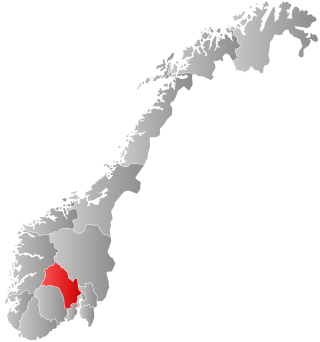
Buskerud is a county and a current electoral district in Norway, bordering Akershus, Oslo, Innlandet, Vestland, Telemark and Vestfold. The region extends from the Oslofjord and Drammensfjorden in the southeast to Hardangervidda mountain range in the northwest. The county administration was in modern times located in Drammen. Buskerud was merged with Akershus and Østfold into the newly created Viken County on 1 January 2020. On 23 February 2022, the Viken County Council voted in a 49 against 38 decision to submit an application to the Norwegian government for a county demerger. Due to this, Buskerud was re-established in 2024.

Oppland is a former county in Norway which existed from 1781 until its dissolution on 1 January 2020. The old Oppland county bordered the counties of Trøndelag, Møre og Romsdal, Sogn og Fjordane, Buskerud, Akershus, Oslo and Hedmark. The county administration was located in the town of Lillehammer.
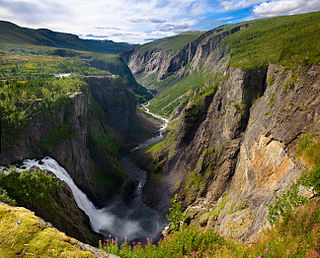
Eidfjord is a municipality in Vestland county, Norway. The municipality is located in the traditional district of Hardanger. The administrative centre of the municipality is the village of Eidfjord, where the majority of the municipal population lives. The other major population centre in the municipality is the village of Øvre Eidfjord.
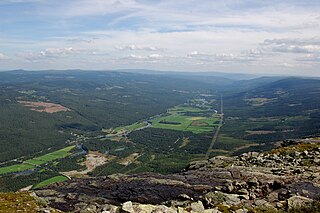
Hemsedal is a municipality in Buskerud county, Norway. It is part of the traditional region of Hallingdal. The administrative centre of the municipality is the village of Trøym. Hemsedal lies on the Norwegian National Road 52. Hemsedal is located 220 km (136.70 mi) northwest of Oslo and 273 km (169.63 mi) from Bergen. In 1897, Hemsedal was separated from the municipality of Gol to become a municipality of its own.

Nesbyen is a town and the administrative center in Nesbyen municipality in the county of Buskerud, Norway. Nesbyen is located in the traditional district of Hallingdal.

Drammenselva is a river in Buskerud county, southeastern Norway.
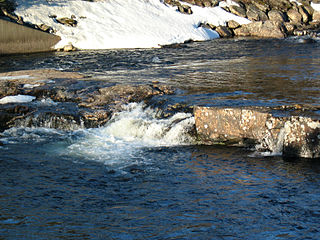
Hallingdalselva is a river which flows through the valley and traditional district of Hallingdal in Buskerud County, Norway. Within the valley, the river is often referred to as the Great River (Storåne).

Vavatn is a lake in the municipality of Hemsedal in Buskerud county, Norway. It is a water source for Gjuva kraftverk, a hydro-electric power plant, which utilizes the waterfall from the lake into the Gjuva river as it enters the valley of Grøndalen. The power station was put into operation in 1957 but was rehabilitated in 1995. The owner-operator is E- CO Energi.
Ørteren is a lake in the municipality of Hol in Buskerud county, Norway.

Rødungen is a lake in Buskerud County, Norway. The lake is located on the border between the municipalities of Ål and Nore og Uvdal. Waterfall from the lake is a power source for Usta kraftverk, a hydro-electric plant. The power station exploits the fall of the Usta River from Rødungen as well as Ustevatn. The plant started production in 1965 and is owned and operated by E- CO Energi.

Nord-Trøndelag Elektrisitetsverk or NTE is a power company serving Nord-Trøndelag in Norway and owned by Nord-Trøndelag county municipality. NTE is one of the largest producers of electricity in Norway, with an annual production of 3,4 TWh per year (2013). In addition, the company is a provider of electrical installation and electrical application retailing as well as optic fiber broadband. The company has its headquarters in Steinkjer.
Skagerak Energi is a Norwegian utility company. The company's main focus is production and distribution of electrical power and other energy, in addition to business areas related to this. The group has about 600 employees, and an annual power production of 5 TWh, about 176,000 grid customers, and an annual revenue of NOK 2 billion.

Eidsiva Energi is a Norwegian energy company based in Hamar with large sections of Oppland and Hedmark as core market, and is the largest producer, distributor and trader of electricity in both counties. The corporation had a revenue of NOK 3.5 billion and market capitalization of NOK 9 billion in 2006. It is owned by Hedmark County as well as by 25 municipalities.
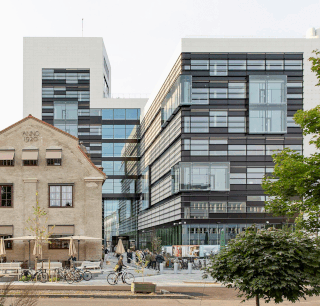
Hafslund AS is a group with ownership within the power industry. The group is fully owned by Oslo municipality. Hafslund's core business streams are hydropower, with 56 percent ownership in Norway's second largest hydropower company Hafslund Eco AS, and district heating, as majority shareholder in Norway's largest district heating company Hafslund Oslo Celsio AS. The group also owns 50 percent of Eidsiva Energi and thereby 50 percent of Norway's grid company Elvia, as well as broadband and bio heat. Hafslund AS also owns 49 percent of Fredrikstad Energi AS. The group has also ownership in Hafslund New Energy with operations within electrification and Hafslund is one of three partners in the offshore wind partnership Blåvinge together with Fred. Olsen Renewables and Ørsted.

Trondheim Energi, formerly Trondheim Energiverk, was a Trondheim, Norway-based power company and a subsidiary of Statkraft. The company owned the power grid and district heating in Trondheim and Klæbu, fourteen hydroelectric power plants in Nea and Nidelva, and five partially owned power plants in the Orkla Valley.
Glitre Energi is a power company based in Drammen, Norway. The company operates electricity retailing, operates the power grid in Drammen, Nedre Eiker and Kongsberg and provides services within broadband. Glitre Energi serves approximately 90,000 customers, supplying electricity to customers in the Norwegian regions of Buskerud and Hadeland. The company is responsible for the power lines in Buskerud, which make up a large distribution network across densely populated areas. Glitre Energy is owned by the City of Drammen (50%) and Buskerud County Municipality (50%). Power production has been spun off in the partially owned subsidiary EB Kraftproduksjon, where EB owns 70% and E-CO Energi owns 30%.

The Aurland Power Station is a hydroelectric power station located in the municipality Aurland in Vestland, Norway, owned by E-CO Energi. It consists of five facilities, Aurland I, Aurland II, Aurland III, Reppa and Vangen, and operates at a combined installed capacity of 1,128 MW, with an average annual production of 2,869 GWh. The construction works were initiated in 1969, and the first production from Aurland I started in 1973.
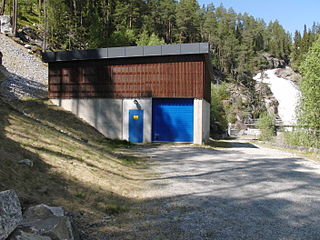
Opheim is a village in Ål municipality in Buskerud, Norway.

Innlandet is a county in Norway. It was created on 1 January 2020 with the merger of the old counties of Oppland and Hedmark. The new county has an area of 52,113 square kilometres (20,121 sq mi), making it the largest county in Norway after Troms og Finnmark was split up in 2024.















